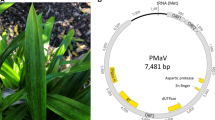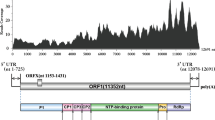Abstract
The genus Bromovirus currently contains six species whose members have relatively narrow host ranges. In the present work, a new bromovirus infecting elderberry (Sambucus nigra L.) is reported. dsRNA was purified and sequenced by next-generation sequencing, and with minimal additional completion by Sanger sequencing, the full tripartite genome was obtained. RNA1 is 3241 nt long and contains ORF1 (1a protein), RNA2 is 2810 nt long and contains ORF2 (2a protein), and RNA3 is 2244 nt long and contains ORF3a (movement protein) and ORF3b (coat protein, CP), separated by an intercistronic poly(A) stretch. Proteins 1a and 2a showed highest sequence identity (69.9% and 69.4%) to the corresponding proteins of melandrium yellow fleck virus. The coat protein showed highest sequence identity (67.9%) to that of brome mosaic virus. The genome shows a typical bromovirus organisation comprising of all the conserved protein domains within the genus. Phylogenetic analysis supports the assignment of this virus as a new member of the genus Bromovirus, for which the name “sambucus virus S” (SVS) is proposed.

Similar content being viewed by others
References
Altschul AF, Madden TL, Schäffer AA, Zhang J, Zhang Z, Miller W, Lipman DJ (1997) Gapped BLAST and PSI-BLAST: a new generation of protein database search programs. Nucleic Acids Res 25:3389–3402
Bawden FC, Chaudhuri RP, Kassanis B (1951) Some properties of broad bean mottle virus. Ann Appl Biol 38:774–784
Boratyn GM, Schäffer AA, Agarwala R, Altschul SF, Lipman DJ, Madden TL (2012) Domain enhanced lookup time accelerated BLAST. Biol Direct 7:12
Candresse T, Marais A, Faure C, Gentit P (2013) Association of Little cherry virus 1 (LChV1) with the Shirofugen stunt disease and characterization of the genome of a divergent LChV1 isolate. Phytopathology 103(3):293–298
Dale JL, Gibbs AJ, Behncken GM (1984) Cassia yellow blotch virus: a new bromovirus from an Australian native legume, Cassia pleurocarpa. J Gen Virol 65:281–288
Hollings M, Horvath J (1981) Melandrium yellow fleck virus. CMI/AAB Descriptions of Plant Viruses No. 236
Kuhn CW (1964) Purification, serology and properties of a new cowpea virus. Phytopathology 54:853–857
Kumar S, Stecher G, Tamura K (2016) MEGA7: molecular evolutionary genetics analysis version 7.0 for bigger datasets. Mol Biol Evol 33:1870–1874
Makkouk KM, Bos L, Rizkallah A, Azzam OI, Katul L (1989) Broad bean mottle virus: Identification, host range, serology, and occurrence on faba bean (Vicia faba) in West Asia and North Africa. Neth J Plant Path 94(4):195–212
Marchler-Bauer A, Bo Y, Han L et al (2017) CDD/SPARCLE: functional classification of proteins via subfamily domain architectures. Nucleic Acids Res 45(D):200–203
McKinney HH, Fellows H, Johnston CO (1942) Mosaic of Bromus inermis. Phytopathology 32(4):331
Valverde RA (1984) Spring beauty latent virus: a new member of the Bromovirus group. Phytopathology 75:395–398
ICTVdB (2017) The Universal Virus Database of the International Committee on Taxonomy of Viruses. https://talk.ictvonline.org. Accessed 18 Aug 2017
Acknowledgements
This study was funded by MEYS, Czech Republic (Grant number COST LD15048), and by a STSM Grant from COST Action FA1407.
Author information
Authors and Affiliations
Corresponding author
Ethics declarations
Conflict of interest
The authors declare that they have no conflict of interest.
Ethical approval
This article does not contain any studies with human participants or animals performed by any of the authors.
Additional information
Handling Editor: Ioannis E. Tzanetakis.
Electronic supplementary material
Below is the link to the electronic supplementary material.
Rights and permissions
About this article
Cite this article
Šafářová, D., Candresse, T. & Navrátil, M. Complete genome sequence of a novel bromovirus infecting elderberry (Sambucus nigra L.) in the Czech Republic. Arch Virol 163, 567–570 (2018). https://doi.org/10.1007/s00705-017-3629-1
Received:
Accepted:
Published:
Issue Date:
DOI: https://doi.org/10.1007/s00705-017-3629-1




